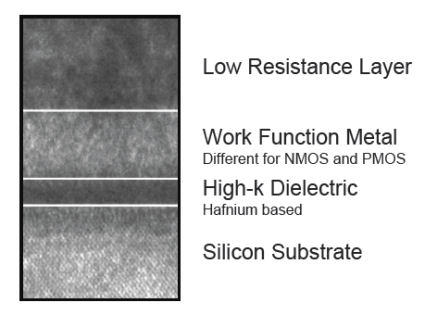Intel Reinvents the Transistor
How come the discovery of ultra-low-k materials was the breakthrough necessary for AMD and IBM to pursue their joint miniaturization strategy, while high-k was the hurdle Intel needed to clear? Interconnects need low-k materials to reduce current leakage where the leads meet the transistors; transistors need high-k materials to conduct charges properly. But could AMD and Intel each have only solved half the problem? Why were both sides hindered by different parts of the 45-nm puzzle?

An electron microscope view of a new HK+MG transistor. Notice the latticework-like detail on the silicon substrate, like an imprint left by a chain-link fence. Those are actually linked atoms. (Courtesy Intel)
"The interconnects on a microprocessor tend to want low-k dielectrics," Intel's Mark Bohr explained to BetaNews, "to provide low capacitance and good interconnect performance. Transistors are quite the opposite. Transistors want a high-k dielectric to increase the gate field effect and increase the switching speed. Now, low-k dielectrics for interconnects are nothing new. Intel had low-k dielectrics on our 0.18 micron technology back in 1999, and of course, Intel and other companies have continued to improve on those low-k films for interconnects over the intervening years, coming up with materials with even lower-k values. So I think the announcement of what AMD and IBM may be using for their 45-nm interconnects is really nothing new; it's just kind of an incremental step over what Intel and others have been doing for the last seven [to] nine years.
"But transistors are a very different animal," Bohr continued. "They need high-k dielectrics and metal gate electrodes. As one other industry executive put it in a keynote just about a month ago, the industry's search for transistors with high-k-plus-metal-gate would be, in his words, 'the Holy Grail of the industry.' In his talk, he didn't expect it to happen until 2010. So I think this is a considerable breakthrough, one [which] will further extend our transistor performance lead over the competition."
Jim McGregor believes this "Holy Grail" has a limited window of opportunity - in fact, it may actually be a stopgap before the entire semiconductor industry finds itself having to adjust its mindset.
"This is an ongoing puzzle," McGregor told BetaNews. "It's going to be here for the next 15 years until they make a drastic change off of silicon. The problem is, power is now the main issue we have to deal with, especially relative to increasing performance or density or anything else. And it's a critical issue that's going to involve manufacturing technology, involve materials technology, and involve semiconductor design."
As we've seen, more miniaturized components should require less power to operate, as the Core 2 Duo and Core 2 Quad series have clearly demonstrated. But at layer thicknesses of just one or two molecules, conventional materials behave differently, leaking current and thus using more power. HK+MG solves Intel's problem today, In-Stat's Jim McGregor believes, but it might crop up again later.
"In the next 15 years, they're going to have to change drastically...until we go to something like carbon nanotubes or diamond wafers, or whatever it's going to be," remarked McGregor. "Obviously nobody's going to make a revolutionary change overnight when they have billions upon billions upon billions of dollars invested into something that's made them money for 30 years, but it's going to have to change. We've reached some barriers that we need to overcome."
Next: The return of clock speed
